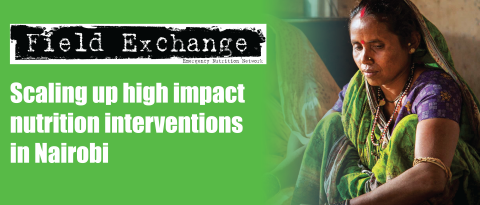Editorial
This 59th issue of Field Exchange covers an interesting range of subjects. Common themes include programme integration, nutrition-sensitive programming and piloting new programme designs. An article by Kassim Lupao and Esther Mogusu describes efforts by Concern Worldwide and UNICEF to scale up and integrate high-impact nutrition interventions (HINI) in health systems in urban Nairobi. While successful in many respects, key challenges have included short-term funding and weak systems into which HINI can be integrated. The authors identify a range of urban-specific challenges and learning.
A second article reports on UNICEF-supported integration of community-based management of acute malnutrition (CMAM) into fixed health facilities in north east Nigeria during a humanitarian crisis. The success of this programme is attributed to strong government leadership and dedicated funding, good communications, use of existing community platforms for community mobilisation, and investment in on-the-job training and supervision. The authors conclude that it is possible to transition from an emergency to a more developmental approach using humanitarian funding and internal UNICEF resources.
An article from CARE Bangladesh describes a sub-district multi-sector approach to addressing malnutrition that uses existing structures to establish community-based multi-sector coordination platforms (committees). These helped coordinate a range of nutrition-specific and nutrition-sensitive activities, including maternal, infant and young child nutrition (MIYCN); water, sanitation and hygiene (WASH); folic acid supplementation; vouchers for health service access; and women’s empowerment. The article claims significant impact on prevalence of wasting and stunting based on baseline and end-line comparisons, so it should be interpreted cautiously. Nevertheless, the cost for the approach at US$1,000 per year per committee seems to suggest a sustainable model.
Field Exchange 59 reports on three other interesting pilot studies. The first is an Action Against Hunger programme in Rajasthan, India, which provides psychosocial counselling for mothers of severely malnourished children, as well as WASH and educative play. An evaluation found that the programme led to early identification of malnourished children, an increase in mean weight gain of children, reduction in defaulter rates and greater post-discharge attendance. Although not expensive, the approach did require significant staff capacity building. The findings were not statistically valid, so again cautious interpretation is needed. However, the experience leads the authors to conclude that there is potential to improve severe acute malnutrition treatment outcomes through staff capacity and infrastructure development to support operationalising government guidelines.
A second pilot programme in the Himalayas of Nepal involved building the capacity of farmers to undertake permaculture farming. Although the programme had no explicit nutrition objectives, an evaluation found higher yields and resulting income, as well as increases in dietary diversity. The author concludes that there is strong potential for positive nutrition impact.
The final article on integration by Cooperazione Internazionale describes a pilot study in Niger targeting WASH to households and communities of severely malnourished children enrolled in outpatient therapeutic programmes. The study found no impact on programme performance, but some impact on non-response and diarrhoea co-morbidity.
This edition also includes two articles looking at infant and young child feeding (IYCF) and maternal nutrition and health. The first is a barrier analysis conducted among internally displaced persons in camps and urban populations in northern Syria, where IYCF practices have remained poor. The analysis concludes that, in order to make progress on IYCF, better access to maternal nutrition services and IYCF support is needed, as well as integration of IYCF support into other sectors, including reproductive health, food security and agriculture.
An article by Vani Sethi, Praveen Kumar and Arjan De Wagt in India reports on the circumstances of mothers of children admitted to four nutrition rehabilitation centres. They found a quarter of mothers were stunted, 23% were underweight and more than a quarter were overweight/obese. Morbidity was common and family planning was low. These findings catalysed the development of a maternal service package integrated within existing government services. This experience spotlights a missed opportunity to provide services for mothers of malnourished children and the need to engage across the health and reproductive health sectors (including family planning) in service delivery.
These articles reflect the considerable effort, from different corners of the world, to integrate and work with existing systems and services and involve multiple sectors in order to maximise opportunities for impact. Capturing impact in operational settings remains an ongoing challenge, with the need to pay careful attention to the quality of evidence on impact. This continues to be a limiting factor to knowing if we are truly moving in the right direction.
Finally, you will notice that we have a shorter print edition than usual, with fewer articles and snappier research summaries. This reflects our New Year’s resolution to deliver a more curated, lighter print edition and make the most of our online facility (www.ennonline.net/fex) to share your experiences quickly and widely. Further developments are being planned through 2019 to maximise our impact and effectiveness, informed by our readers and contributors. The editorial team welcomes feedback at any time (please see contacts below).
Happy digested reading.
Jeremy Shoham & Marie McGrath, Field Exchange Co-editors
Please send feedback to Chloe Angood, Field Exchange Sub-editor.


